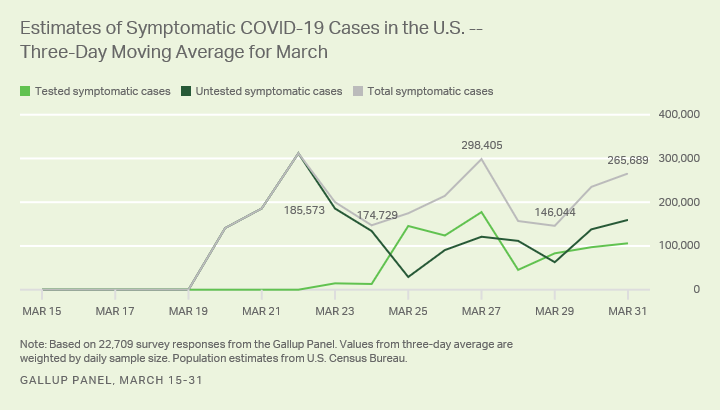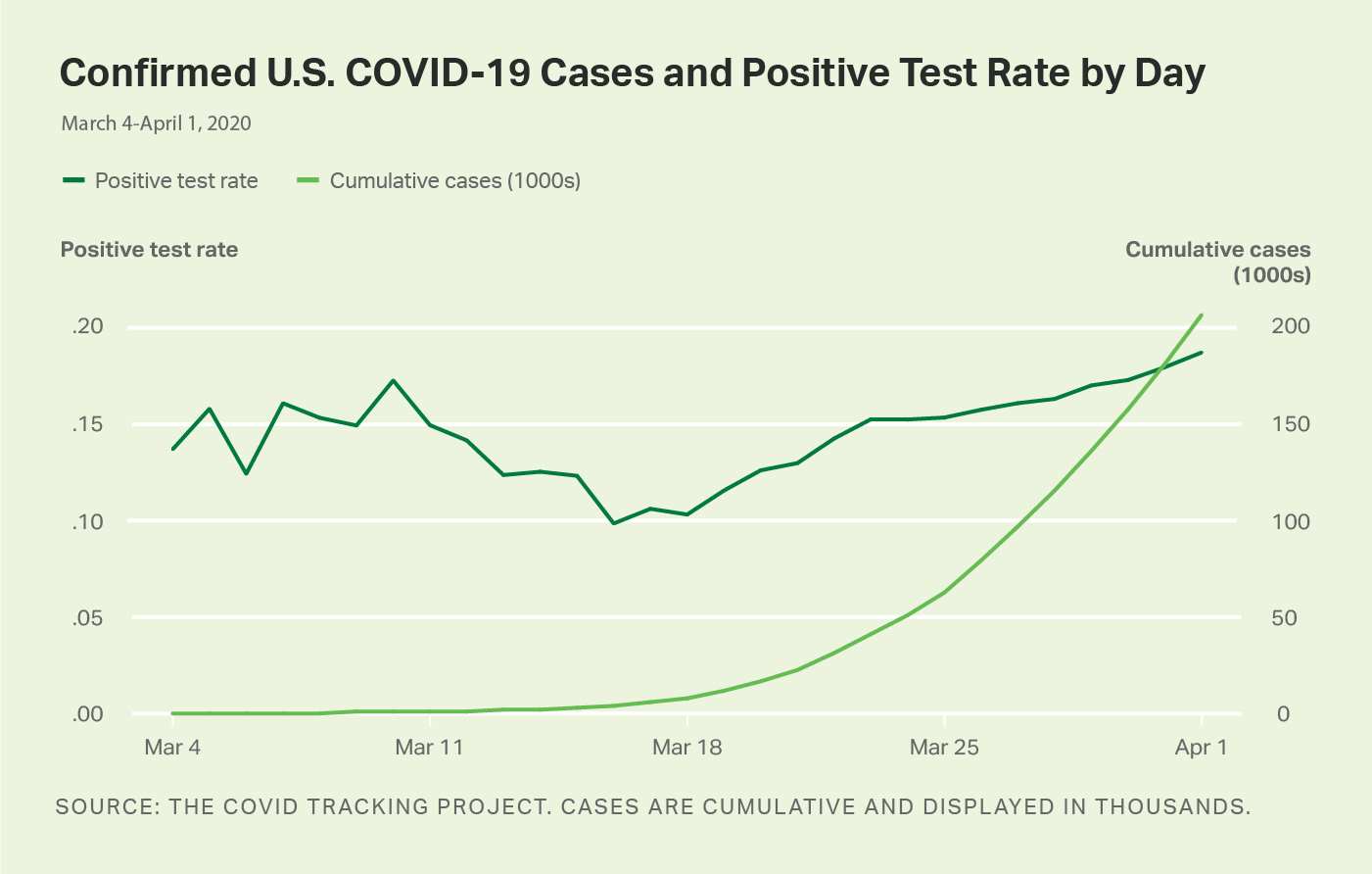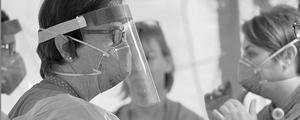Efforts to accurately track the outbreak of COVID-19 in the U.S. have been hampered by a lack of access to testing. While the number of tests performed in the U.S. has scaled up rapidly in the past two weeks, so has the underlying number of infected individuals in need of testing. New data from Gallup suggest that the number of confirmed COVID-19 cases measured March 31 would more than double (or more precisely increase by a factor of 2.5) if people who requested a test, were symptomatic, and visited with a healthcare provider were actually tested.
As of the three-day polling period ending March 31, I estimate that at least 266,000 Americans would test positive for COVID-19 if all symptomatic people who wanted a test got one. That compares to an estimated 106,000 Americans who have tested positive, according to survey data from the Gallup Panel, and 165,000 reported cases through March 31, according to data published from official sources.
| Share of U.S. population | Estimate for U.S. | ||||||||||||||||||||||||||||||||||||||||||||||||||||||||||||||||||||||||||||||||||||||||||||||||||
|---|---|---|---|---|---|---|---|---|---|---|---|---|---|---|---|---|---|---|---|---|---|---|---|---|---|---|---|---|---|---|---|---|---|---|---|---|---|---|---|---|---|---|---|---|---|---|---|---|---|---|---|---|---|---|---|---|---|---|---|---|---|---|---|---|---|---|---|---|---|---|---|---|---|---|---|---|---|---|---|---|---|---|---|---|---|---|---|---|---|---|---|---|---|---|---|---|---|---|---|
| % | # | ||||||||||||||||||||||||||||||||||||||||||||||||||||||||||||||||||||||||||||||||||||||||||||||||||
| Has had fever in past 30 days | 6.40 | 20,532,662 | |||||||||||||||||||||||||||||||||||||||||||||||||||||||||||||||||||||||||||||||||||||||||||||||||
| Has had fever in past 30 days, saw health professional | 2.23 | 7,166,809 | |||||||||||||||||||||||||||||||||||||||||||||||||||||||||||||||||||||||||||||||||||||||||||||||||
| Has had fever in past 30 days, saw health professional, received COVID test | 0.11 | 344,053 | |||||||||||||||||||||||||||||||||||||||||||||||||||||||||||||||||||||||||||||||||||||||||||||||||
| Has had fever in past 30 days, saw health professional, received COVID test, tested positive | 0.03 | 106,092 | |||||||||||||||||||||||||||||||||||||||||||||||||||||||||||||||||||||||||||||||||||||||||||||||||
| Has had fever in past 30 days, saw health professional, denied COVID test | 0.28 | 886,903 | |||||||||||||||||||||||||||||||||||||||||||||||||||||||||||||||||||||||||||||||||||||||||||||||||
| Has had fever in past 30 days, saw health professional, denied COVID test, likely positive | 0.05 | 159,643 | |||||||||||||||||||||||||||||||||||||||||||||||||||||||||||||||||||||||||||||||||||||||||||||||||
| Estimated symptomatic COVID-19 cases | 0.08 | 265,735 | |||||||||||||||||||||||||||||||||||||||||||||||||||||||||||||||||||||||||||||||||||||||||||||||||
| Ratio of estimated COVID-19 symptomatic cases to confirmed cases | 2.50 | 2.50 | |||||||||||||||||||||||||||||||||||||||||||||||||||||||||||||||||||||||||||||||||||||||||||||||||
| Sample size equals 3,234 U.S. adults. The population estimates above assume that symptomatic cases are just as likely in children. Assumes that 18% of people who request a test will test positive, which is the current positive test rate reported from cumulative data tracked on The COVID Tracking Project, https://covidtracking.com, and is very close to the positive testing rate (17%) in the Gallup Panel. Standard error for positive COVID test results is 0.06%. Standard error for share denied COVID test is 0.09%. | |||||||||||||||||||||||||||||||||||||||||||||||||||||||||||||||||||||||||||||||||||||||||||||||||||
| Gallup Panel, March 29-31, 2020 | |||||||||||||||||||||||||||||||||||||||||||||||||||||||||||||||||||||||||||||||||||||||||||||||||||
The implication of this research is that the number of cases reported at any given time (239,279, as of April 3) should be multiplied by 2.5 to account for lack of access to testing for symptomatic people who seek treatment. That suggests a current caseload of roughly 600,000 through April 3. This is a conservative estimate for several reasons. First, it ignores nonresponse error, which may be an issue for people too sick to respond to the survey or already hospitalized. In fact, we estimate that an additional 198,000 confirmed COVID-19 cases could be present within the households of surveyed respondents. Second, this analysis assumes that only people who are symptomatic and seek treatment are COVID-19 positive, which we know is not the case. One recent study found that 18% of people with COVID-19 are asymptomatic, which, if applied to the most recent estimate, would bring the April 3 case total estimate to 730,000 Americans with COVID-19. We cannot know with current information how many people with symptoms who do not seek treatment are COVID-19 positive, but that is another reason to believe these are conservative estimates.
The 2.5 factor is likely to respond to the rate of testing. As testing capacity expands, it will likely fall. Our data show the ratio would have been 13.7 for the three-day period ending on March 23. Gallup will monitor dynamics in this rate.
The survey includes two screening questions before people are asked if they have been tested for COVID-19. First, people are asked whether they have been ill with a fever within the past 30 days. If they answer yes, which 6.4% of people did, they are then asked whether they saw a health professional for the illness, which applies to 2.2%. Among those who said they have had a fever in the past 30 days, two-thirds (65%) said they did not seek treatment.
Those who report having had a fever and visiting a health professional are then asked whether they received a novel coronavirus (COVID-19) test: 95% did not receive one. Among those who did not receive a COVID-19 test, a test was requested in 13% of cases -- either by the individual or their attending healthcare professional.

The COVID Tracking Project, which collects data from state health departments, shows that 18% of all U.S. tests for COVID-19 are positive, which nearly matches the rate found in Gallup survey data over most of March (17%, from March 13 to March 31). Applying the 18% positive testing rate number to the symptomatic population who sought treatment but were denied a test upon request suggests that 0.05% of the U.S. population would test positive if given full access. That compares to 0.03% of Americans who have been tested. This translates into an additional 159,643 cases that are currently going undetected despite the patient seeking treatment and having symptoms.
These results are sensitive to the dates used in the analysis, but recent dates consistently show that the number of undetected symptomatic cases is at least equal to the detected symptomatic cases. The figure above plots the results for both of these estimates and the total number of cases by day using a three-day moving average to smooth out daily variation. This longer analysis was conducted from a representative survey of 22,709 U.S. adults conducted by Gallup March 13-March 31 through the Gallup Panel, a group of people who were previously randomly selected for Gallup surveys and agreed to be recontacted.

These results shed light on one aspect of this pandemic that has been difficult to measure, as testing access remains a problem. When asked if they were confident they could get a coronavirus test if they thought they had the disease, 27% of the population said no. Data on the percentage of tests yielding positive results has been increasing, according to data from state sources compiled by The COVID Tracking Project. This suggests that testing capacity may be under strain as the disease spreads.
Beyond obtaining more accurate estimates for symptomatic cases, expanded testing capacity would also shed light on the large number of people thought to be asymptomatic carriers and potential transmitters of the disease. In a recent interview, Dr. Robert Redfield, director of the Centers for Disease Control and Prevention, stated that "a significant number of individuals that are infected actually remain asymptomatic." Whether asymptomatic or not, failing to identify people with the disease will make quarantine and suppression much more difficult.




